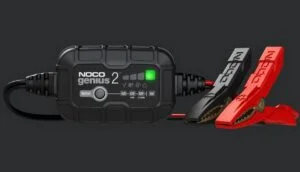Getting a flat battery on your car is a pain. If it keeps happening regularly, then you need to do a little investigation to find the problem. A battery that keeps being drained entirely flat will not last very long.
But if your alternator is working, what could cause the battery to go flat? This brief article examines the possible causes and discusses some ways to fix the problem.
Bad Battery
Batteries can have a tough life, continually being discharged and partially charged. Add to that the environmental conditions, such as high heat or extreme cold, and a battery’s life is finite.
If you have a battery charger, remove the car’s battery if necessary, and charge it fully. Even better if you have a modern maintenance battery charger. These can sometimes revive a completely dead battery. The battery charger may also help you diagnose a faulty battery.
After fully charging the battery, the same problem occurs, then consider replacing or reconditioning the battery.
Find purchasing options for Smart Battery Charger that can revive a dead battery here:

NOCO GENIUS2

CTEK MXS 5.0
Loose or Corroded Battery Connections
There must be a good connection between the battery and the vehicle’s cables. Damage, corrosion, or a loose connection will cause resistance, preventing the battery from charging correctly.
The first thing to look for is corrosion around the terminals and cable ends. It usually has a fluffy white look and can cover the whole connection. Disconnect the battery, and if required, remove it from the car for easier access. You can use commercial cleaners, wire wool, and even sandpaper to clean the terminals. Baking soda is also suitable for cleaning or soaking the terminals in white vinegar.
You may be able to disconnect the terminals from the battery for better cleaning. It is not unknown for the battery terminals to be at fault. If you see a purple or white foam at the base of the terminal, change them.
Once everything is clean, refit the battery and check if the problem is resolved. Make sure you tighten the cables to the terminals.
Buy Battery Terminals to replace the corroded connections here:

Fastronix Military Battery Terminal

Cllena Military Battery Terminal
Ground Connection Issue
A poor battery ground connection can cause many issues. One very common problem is the connection between the battery and the starter motor.
If the ground connection is not good, you’ll get a lot of issues with poor starting. This might make you think the battery is terrible when it’s a poor starter motor ground connection.
Parasitic Battery Drain
What does “parasitic battery drain” mean?
The first question most people ask is, what’s a parasitic battery drain? Anything that causes the battery to run down after the ignition is turned off, is a parasitic battery drain.
For example, the most common parasitic drain is a short circuit somewhere. This can quickly flatten your battery. Other problems can be an interior light or trunk light that does not switch off correctly. Less obvious is the light in the glove box.
There could be a fault in your ignition circuit. This could leave the radio on when the car is switched off. Most car radios have a timer so that the radio switches off after a set time, often an hour. If this has failed, it could also cause an issue.
How to fix the parasitic drain problem?
Luckily, it is effortless to detect if you have a parasitic drain. However, it’s sometimes more challenging to find the cause. You will require an amp meter for this test. Either borrow one, or they can be bought quite cheaply.
To do a parasitic drain test, follow the following procedure:
- Ensure the vehicle ignition is switched off
- Make sure all the vehicle’s electrical items are switched off.
- Close all the vehicle doors, including the trunk.
- Disconnect the negative battery cable
- Connect the amp meter inline with the negative cable:
- Connect the negative car cable to one of the amp meter terminals
- Then connect the other amp meter terminal to the negative terminal on the battery.
Once connected, the amp meter should read around 0.2 amps or less. If it reads anymore, you have a battery drain somewhere.
To find the fault is going to take a bit of detective work. Follow the procedure outlined below:
- First, you’ll need to find the fusebox.
- Now, one at a time, pull a fuse and recheck the amp meter.
- If the amp meter is now showing 0.2 amps or less, you’ve found the troublesome circuit.
- If there is no change, refit the fuse and try pulling another.
- Once you’ve identified the circuit, you should be able to identify the cause of the problem. A little more investigation should quickly find the fault.
In very rare cases, you could have two or more circuits causing the problem. In this case, as you pull each fuse, the amp meter reading will drop a little. Please note which circuit it is and continue pulling fuses until the amp meter reading is 0.2 or less.
Here’s an excellent instructional video for checking parasitic battery drains.
Drained Battery
If you don’t use your car regularly, then the battery will drain down. It’s a common misconception to think that if everything in the car is switched off, the battery will remain fully charged.
Even while a car is in storage, there is a small drain on the battery. It’s only in milliamperes, but over a long period, it will completely flatten your battery. How long this takes depends on the condition of your battery.
The other common mistake is only to use your car for short journeys. Starting your engine puts a significant strain on your battery. Only driving a few miles will not recharge it sufficiently. Eventually, the battery will not have enough charge to turn the engine over.
There are two ways to avoid your battery draining:
- Use a Battery Tender in maintenance mode and connect it every time you park your car at home.
- Drive sufficient miles to recharge the battery. It usually will take around 20 minutes of driving to do this. It will take longer at night when you have the lights on.
Wiring Issue
Wiring issues can be more difficult to find and fix, but there are simple things you can do. When you are checking cables, there are several things to look for:
- Damage to the outer sleeve. This is the insulation that prevents the wire from touching anything metallic and also protects it from corrosion.
- Corrosion on terminals and plugs
- Any place the wire is tightly bent. This can cause damage internally that you cannot see
Some common cables that you should check include the following:
- The wire that connects the battery to the fuse panel: This is usually under the hood, but some vehicles have them in the trunk.
- Cables between the battery and the ignition switch.
- The connection from the alternator to the battery. A fault here can be detected by checking the output of the alternator. If it’s providing a good output, then inspect the cable carefully. To check the alternator output, first, make sure the fuses are good. Now measure the voltage at the battery. With the engine running, you should get around 14.5 volts. This means the alternator is supplying enough power to charge the battery. If not, then the problem could be in the wiring.
Sun Visor Issue
Many cars have a small light on the sun visor mirror. There are two possible reasons this could drain your battery:
- The sliding cover is not making the switch that turns off the light. With the light on constantly, your battery will drain overnight.
- There could be a short in the cable that makes the light stay on permanently.
In either case, remove the fuse for the mirror light, so stop it draining the battery. Now you have time to fix the problem or take it to a mechanic.
Conclusion
Problems with your battery and charging circuits are not only a pain but can also prove expensive.
Regularly going to start your car and finding the battery flat is annoying. You’ll be late for wherever you were going, and it might be flat again when you want to come home.
But it can also hit you in the pocket. Regularly letting your battery go entirely flat will shorten its working life. Plus, you are probably putting additional strain on other parts of your car.
In short, as soon as you suspect there is a charging problem, get it sorted out. It will be cheaper in the long run.
